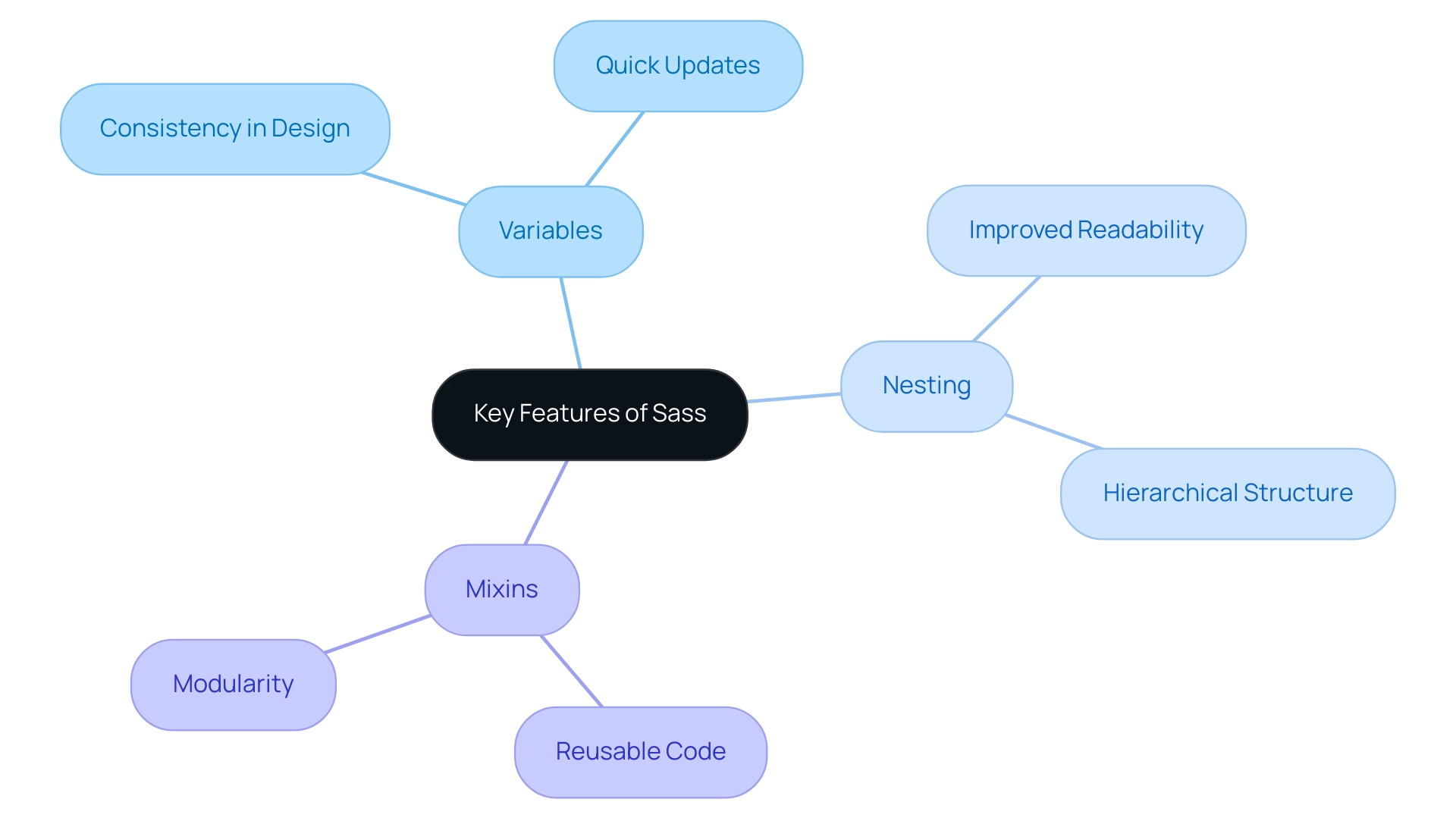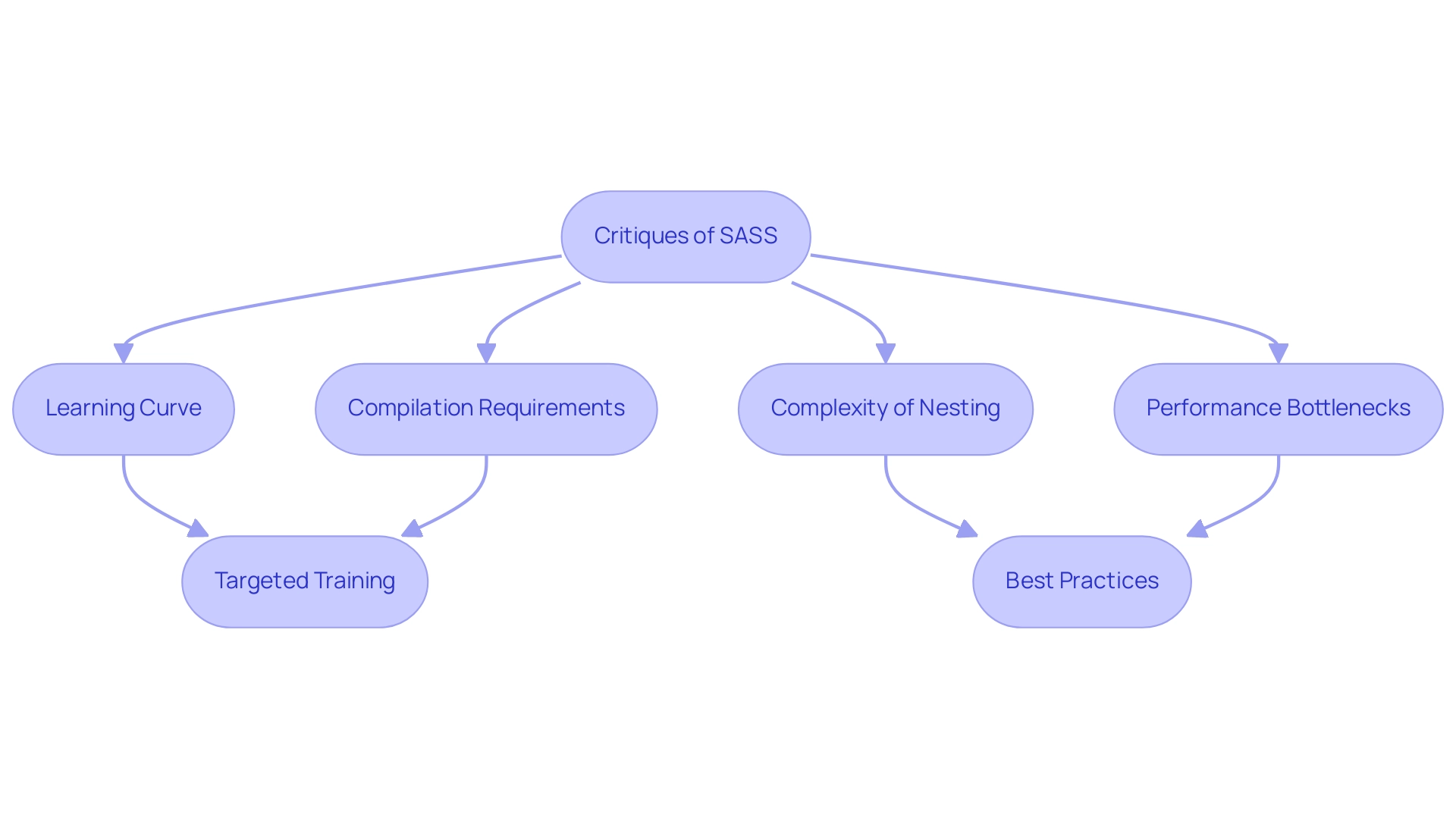Overview
The article provides a comprehensive overview of the CSS preprocessor Sass, highlighting its key features, benefits, and challenges in modern web development. It explains that Sass enhances coding efficiency through variables, nesting, and mixins, while also addressing concerns such as the learning curve and potential performance issues, ultimately positioning Sass as a vital tool for programmers seeking to improve their stylesheets and workflows.
Introduction
In the realm of web development, staying ahead of the curve is paramount, and CSS preprocessors like Sass are at the forefront of this evolution. By transforming the way developers approach styling, Sass introduces powerful features that enhance maintainability, streamline workflows, and foster collaboration.
As more developers embrace these tools, they unlock the potential for creating organized, efficient stylesheets that not only elevate the quality of their projects but also significantly boost productivity. This article delves into the key aspects of Sass, from its fundamental features to installation tips, and explores the myriad benefits it offers, alongside a balanced view of its limitations.
For those looking to optimize their coding practices and embrace modern best practices, understanding Sass is not just beneficial—it's essential.
Understanding CSS Preprocessors: An Introduction to Sass
The CSS preprocessor Sass, along with other CSS preprocessors, plays a crucial role in modern web development by extending traditional CSS capabilities. They enable creators to build more maintainable and efficient stylesheets through features like variables, nesting, and mixins. By compiling the CSS preprocessor Sass into standard CSS, programmers can significantly streamline their workflow and enhance the quality of their stylesheets.
As Anthony notes,
I was of the 'real men don’t need preprocessors' variety, until I finally thought, ‘Oh well, let’s just give it a try, it won’t hurt.’
This illustrates a common transformation in perspective, as many programmers recognize that preprocessors enhance productivity, particularly in larger projects where organization is key. Despite initial skepticism, as emphasized in the case study titled 'Perception of Preprocessors,' many programmers have acknowledged that CSS preprocessors, such as SASS, can enhance productivity and code organization. Additionally, CSS-Tricks remains a top resource for CSS, showcasing the community's dedication to supporting individuals in adopting best practices.
With a prominent market share among CSS preprocessors and the relatively newer Stylus having been available for 14 years, comprehending its features is crucial for any web programmer aiming to adopt modern best practices and maximize coding efficiency. Recent advancements in the framework continue to enhance its functionality, establishing it as an essential resource for ambitious programmers who aim to create responsive, accessible, and fast websites.
Key Features of Sass: Variables, Nesting, and Mixins
The preprocessor significantly enhances the CSS coding experience with its powerful features. Variables in this stylesheet language empower programmers to store consistent values—like colors and fonts—facilitating quick updates across entire stylesheets. This consistency is vital for maintaining a cohesive design.
Nesting is another notable feature that enables programmers to arrange CSS selectors hierarchically, reflecting the structure of HTML. This not only improves readability but also streamlines the coding process, making it easier to navigate complex styles. Furthermore, mixins provide reusable blocks of code that encapsulate styles and even functions, promoting modularity and reducing redundancy in stylesheets.
Collectively, these characteristics of this stylesheet language not only enhance coding efficiency but also establish it as a favored tool among programmers aiming to optimize their workflows. As of April 14, 2013, 200 sites reported using version 6.x-1.x of the stylesheet language, showcasing its growing adoption in the industry. Furthermore, as demonstrated in the case study of Node.js dominance, where it remains the top runtime for frontend development, the incorporation of CSS preprocessors like Sass is essential for developers seeking to improve their coding practices.
Marek Gajda, CTO at The Software House, emphasizes the significance of such efficient practices, stating, 'By embracing DXPs, businesses can break down these silos and move towards a more integrated and user-focused strategy,' which aligns with the advantages of utilizing a CSS preprocessor like Sass.

Getting Started with Sass: Installation and Integration
Getting started with the styling language is a streamlined process designed for efficiency. Developers can install the stylesheet language through npm (Node Package Manager), download the package from GitHub, or use package managers like Chocolatey for Windows, making it accessible for various operating systems. For instance, Mac and Linux users can easily install Dart using Homebrew with the command brew install sass/sass/dart.
As Dylan Wang, a Backend & AI Software Engineer, notes, "Vite is an emerging front-end building tool that is particularly suitable for modern JavaScript frameworks such as Vue and React," highlighting the importance of choosing the right tools for effective integration. Once the installation is complete, integrating the preprocessor into existing projects involves configuring the build process to compile preprocessor files into standard CSS. This can be accomplished through popular build tools such as Webpack, Gulp, or Grunt, which automate the compilation process and improve workflows.
A case study on establishing a stylesheet language demonstrates that the process includes:
- Installing Node.js and npm
- Creating a project folder
- Initializing npm
- Installing the stylesheet language as a necessary component
Successfully converting style files into CSS enables real-time observation of changes, thus improving the workflow. By taking these initial steps, developers can seamlessly incorporate the preprocessor into their coding practices, leading to improved efficiency and productivity from the outset.
Furthermore, recent statistics show a rising trend in the use of a CSS preprocessor, indicating its significance and efficiency in contemporary web design.
Benefits of Using Sass: Why Choose a Preprocessor?
Adopting the CSS preprocessor Sass significantly enhances web development efficiency when compared to traditional CSS. One of the standout benefits of the CSS preprocessor Sass is its capacity for improved maintainability; by utilizing variables and mixins, programmers can minimize code repetition and ensure consistency throughout their stylesheets. The nesting feature of the CSS preprocessor Sass further organizes styles, allowing programmers to navigate and modify code with greater ease.
This structured approach not only clarifies individual styles when using a CSS preprocessor Sass but also fosters collaboration among team members, enhancing overall project coherence. As noted by Marek Gajda, CTO at The Software House,
Instead of using technology as a barrier between teams, the goal is to use it to improve collaboration, creating a seamless, consistent experience for users across all touchpoints.
This is particularly relevant as tools like Kodezi CLI emerge, which not only enable teams to auto-heal their codebases in seconds but also provide features like real-time error detection and automated code formatting, eliminating the time wasted on pull requests.
In today's environment, where the cloud migration market is expected to expand from USD 232.51 billion to USD 806.41 billion by 2029, the rising demand for effective web creation tools that aid scalability and collaboration becomes clear. Furthermore, a recent case study on remote work tools illustrates how mobile developers equipped with the right collaborative tools can significantly enhance productivity and project outcomes. With these enhancements, it's clear that the framework, combined with tools like Kodezi, contributes to notable productivity improvements, making them indispensable assets in modern web development strategies for 2024 and beyond.
Critiques of Sass: Understanding the Limitations
While the CSS preprocessor SASS offers numerous advantages for enhancing CSS workflows, it is crucial to recognize its limitations, particularly for newcomers. Recent discussions indicate that in 2024, a significant number of beginners find the learning curve associated with the advanced features of the stylesheet language to be challenging. This complexity can lead to frustrations, especially when features like nesting are overutilized, resulting in stylesheets that become overly intricate and hard to maintain.
As Marek Gajda, CTO at The Software House, notes, 'we may have introduced overly complex solutions to address what was, at its core, a simple communication issue between teams.' This sentiment resonates with many developers who struggle with the intricacies of the stylesheet language. Additionally, the requirement for a compilation step introduces another layer of complexity to the development process.
Performance remains a key focus for tech managers in 2024, and while the CSS preprocessor SASS can enhance CSS efficiency, its complexities may also introduce performance bottlenecks if not managed correctly. Moreover, taking into account that MacOS is the favored operating system for 54.7% of frontend programmers, it is crucial to recognize the setting in which the stylesheet language is being employed. However, with targeted training and adherence to best practices, developers can successfully navigate these challenges.
By effectively managing complexity within the CSS preprocessor Sass stylesheets, they can harness its strengths, ultimately optimizing their CSS practices and enhancing productivity.

Conclusion
Embracing Sass as a CSS preprocessor is a strategic move for web developers looking to enhance their coding efficiency and maintainability. The powerful features of Sass—such as variables, nesting, and mixins—enable developers to create organized and reusable stylesheets that streamline their workflows. This not only results in cleaner code but also fosters collaboration among team members, ultimately elevating the quality of web projects.
While it’s important to acknowledge the learning curve and potential complexities associated with Sass, especially for newcomers, the benefits far outweigh the challenges. With proper training and best practices, developers can effectively leverage Sass to build responsive and accessible websites. The integration of Sass into modern development environments, alongside tools that support automation and real-time error detection, underscores its relevance in today's fast-paced tech landscape.
In conclusion, adopting Sass is not merely a trend but a necessity for developers aiming to optimize their workflows and maximize productivity. As the web development industry continues to evolve, mastering Sass will empower developers to stay ahead of the curve, ensuring they deliver high-quality projects with efficiency and ease.
Frequently Asked Questions
What is Sass and why is it important in web development?
Sass is a CSS preprocessor that extends traditional CSS capabilities, allowing for the creation of more maintainable and efficient stylesheets through features like variables, nesting, and mixins. It plays a crucial role in modern web development by streamlining workflows and enhancing stylesheet quality.
How do CSS preprocessors like Sass enhance productivity?
CSS preprocessors enhance productivity by providing features that improve code organization and maintainability, especially in larger projects. Many programmers initially skeptical of preprocessors have recognized their benefits, as noted in the case study titled 'Perception of Preprocessors.'
What are the key features of Sass?
The key features of Sass include: Variables: Allow programmers to store consistent values, such as colors and fonts, for quick updates across stylesheets. Nesting: Enables hierarchical arrangement of CSS selectors, improving readability and simplifying navigation of complex styles. Mixins: Provide reusable blocks of code that encapsulate styles and functions, promoting modularity and reducing redundancy.
How has the adoption of Sass been reflected in the industry?
As of April 14, 2013, 200 sites reported using version 6.x-1.x of Sass, indicating its growing adoption. Additionally, the incorporation of CSS preprocessors like Sass is essential for developers looking to improve their coding practices, as seen in the ongoing popularity of Node.js in frontend development.
What is the significance of using a CSS preprocessor like Sass according to industry experts?
Industry experts, such as Marek Gajda, emphasize that using efficient practices like CSS preprocessors can help businesses break down silos and adopt a more integrated, user-focused strategy, aligning with the advantages offered by tools like Sass.




